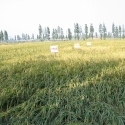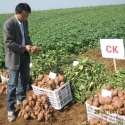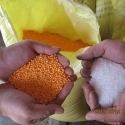Application of NE system on maize in south China

Maize is one of the most important grain crops with higher productivity in the world. Anhui province is one of the main maize production provinces in China and its maize planting areas has reached 0.761 million hectares in 2010. With the maize planting area greatly extended in recent years, the issues of maize farming have presented as well. The most significant issue is lower grain yield in this province (4.11 t/ha) compare to the average of the country (5.45 t/ha).
Investigation result showed that the issue is mainly caused by unbalanced fertilization (in most cases, over use nitrogen fertilizer but much less or no potassium fertilizer), except the other yield limiting factors such as local climate condition. Therefore, based on the success use of the maize Nutrient Management Expert system (NE) in north China, IPNI China program introduced the NE system to south China and cooperated with the Soil and Fertilizer Institute, Anhui Academy of Agricultural Science during 2013-2014, to study the response and modify the NE system in this area.
Total 6 maize NE system field experiments were conducted in Bozhou county and Lixin county of Anhui province under maize-wheat rotation with 7 treatments. The treatments include: ①OPTE (fertilization follow the recommendation by NE system), ②OPTs (fertilization based on the soil testing), ③FP (farmer practice), ④OPTE-N, ⑤OPTE-P, ⑥OPTE-K, and ⑦CK (no fertilization). For the OPTE treatment, NPK fertilizers application rate was N-P2O5-K2O = 182-72-90 kg/ha, for the OPTs treatment was N-P2O5-K2O = 210-90-90 kg/ha, and for the FP treatment was N-P2O5-K2O = 225-120-60 kg/ha, respectively. All of the P fertilizer (SSP), potassium fertilizer (KCl) and 60% of nitrogen fertilizer (urea) were applied for basal dressing, 40% of nitrogen fertilizer (urea) used for top dressing. The maize was sowed on June 15 and harvested on September 25, 2013.
Field experimental results indicated that the NE system significant improved maize development, grain yield and farmers’ economic benefit compare to local conventional practice. It is a good fertilization recommend tool for maize farming and has potential to further improve the parameters in future. Compare to the OPTs treatment, although OPTE treatment has almost no yield difference, but it reduced the application rates of N and P fertilizers. That means the NE system is more efficient than the fertilization recommend system based on soil testing.
The average grain yield (8,246 kg/ha) of OPTE treatments in the 6 experimental sites increased by 0.06% over OPTs treatments (8,241 kg/ha), by 9.0% over FP treatments (7,565 kg/ha), by 28.2% over OPTE-N treatments (6,432 kg/ha), by 3.98% over OPTE-P treatments (7,930 kg/ha), by 11.5% over OPTE-K treatments (7,394 kg/ha) and by 31.5% over CK treatments (6,272 kg/ha), respectively. Compare to FP treatment, OPTE treatment increased net income by RMB 2,278/ha (USD 367/ha).




